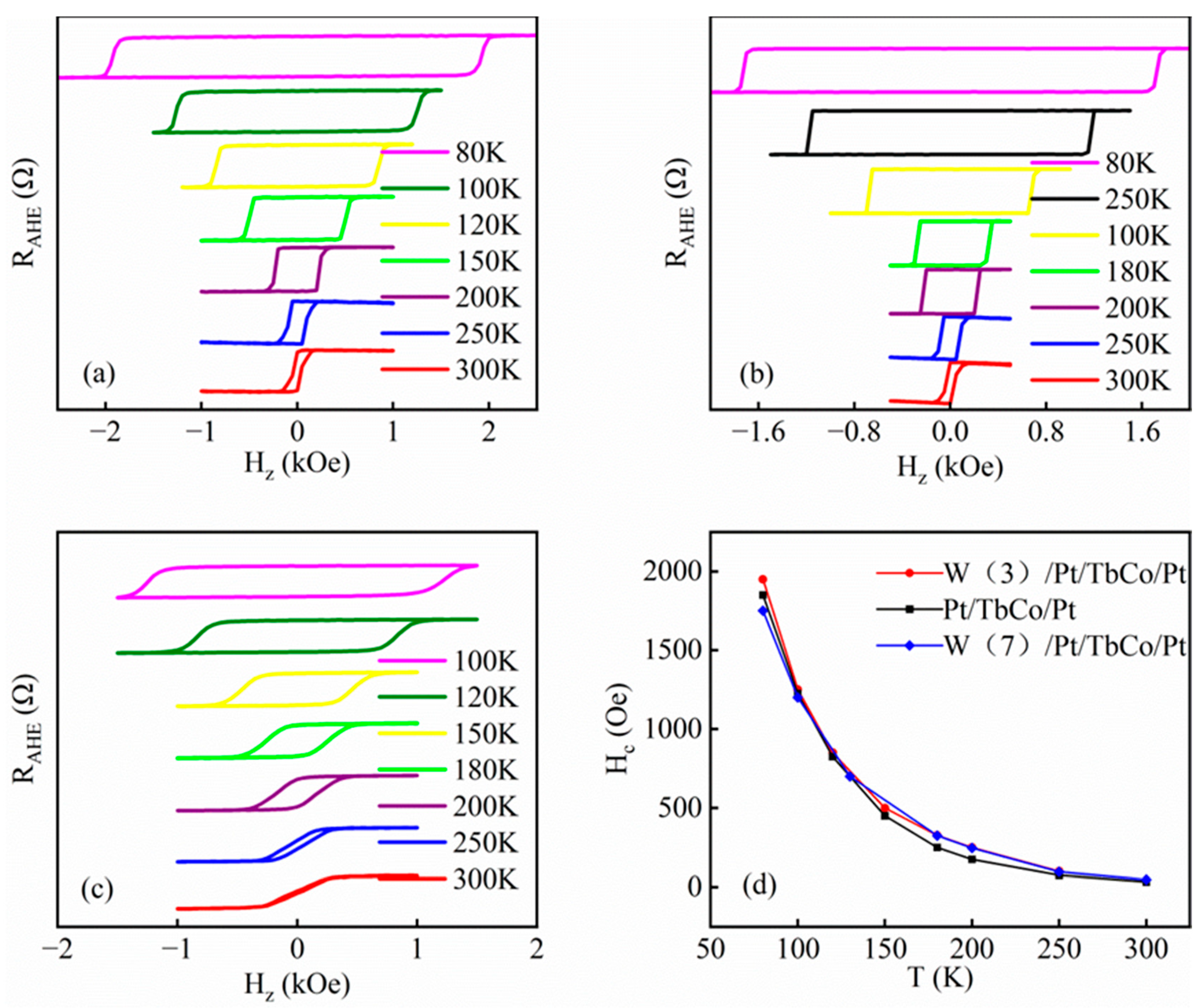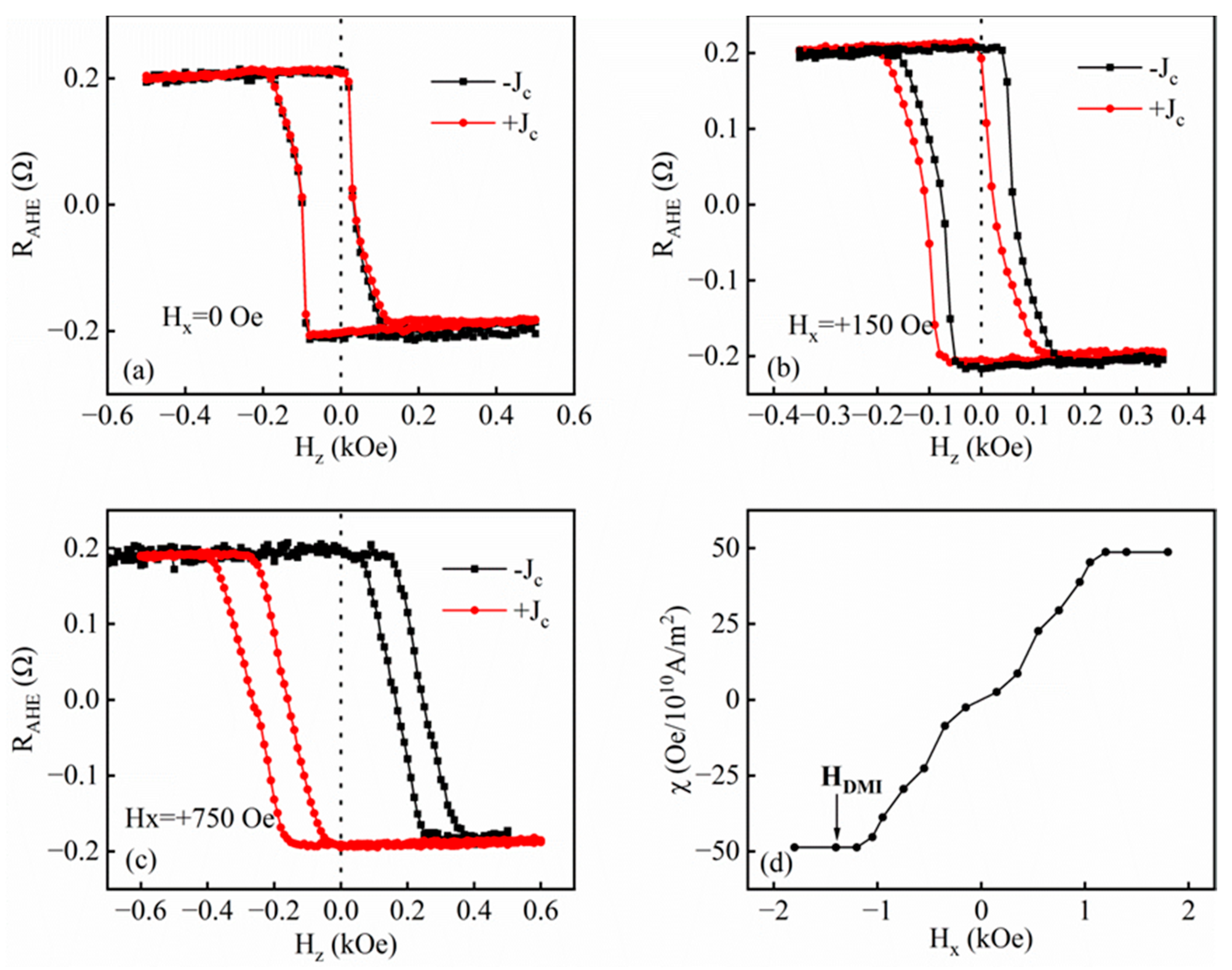Study on Anomalous Hall Effect and Spin–Orbit Torque Effect of TbCo-Based Multilayer Films
Abstract
:1. Introduction
2. Materials and Methods
3. Results
4. Conclusions
Author Contributions
Funding
Data Availability Statement
Conflicts of Interest
References
- Reza, A.K.; Roy, K. Fast switching in CoTb based ferrimagnetic tunnel junction. J. Appl. Phys. 2019, 126, 023901. [Google Scholar] [CrossRef]
- Wang, Z.; Wang, W.; Tang, J.; Tung, L.D.; Spinu, L.; Zhou, W. Extraordinary Hall effect and ferromagnetism in Fe-doped reduced rutile. Appl. Phys. Lett. 2003, 83, 518–520. [Google Scholar] [CrossRef]
- Yu, J.; Liu, L.; Deng, J.; Zhou, C.; Liu, H.; Poh, F.; Chen, J. Topological Hall effect in ferrimagnetic CoTb single layer. J. Magn. Magn. Mater. 2019, 487, 165316. [Google Scholar] [CrossRef]
- Chernyshov, A.; Overby, M.; Liu, X.; Furdyna, J.K.; Lyanda-Geller, Y.; Rokhinson, L.P. Evidence for reversible control of magnetization in a ferromagnetic material by means of spin–orbit magnetic field. Nat. Phys. 2009, 5, 656–659. [Google Scholar] [CrossRef]
- Zhu, T.; Yang, Y.; Yu, R.C.; Ambaye, H.; Lauter, V.; Xiao, J.Q. The study of perpendicular magnetic anisotropy in CoFeB sandwiched by MgO and tantalum layers using polarized neutron reflectometry. Appl. Phys. Lett. 2012, 100, 202406. [Google Scholar] [CrossRef]
- Nayak, A.K.; Fischer, J.E.; Sun, Y.; Yan, B.; Karel, J.; Komarek, A.C.; Shekhar, C.; Kumar, N.; Schnelle, W.; Kubler, J.; et al. Large anomalous Hall effect driven by a nonvanishing Berry curvature in the noncolinear antiferromagnet Mn3Ge. Sci. Adv. 2016, 2, e1501870. [Google Scholar] [CrossRef] [PubMed]
- Ghosh, A.; Garello, K.; Avci, C.O.; Gabureac, M.; Gambardella, P. Interface-Enhanced Spin-Orbit Torques and Current-Induced Magnetization Switching of Pd/Co/AlOx Layers. Phys. Rev. A 2017, 7, 14004. [Google Scholar] [CrossRef]
- Jacak, E.J. Unconventional fractional quantum Hall effect in bilayer graphene. J. Sci. Rep. 2017, 7, 8720. [Google Scholar] [CrossRef]
- Chang, C.Z.; Liu, C.X.; MacDonald, A.H. Colloquium: Quantum anomalous Hall effect. J. Rev. Mod. Phys. 2023, 95, 011002. [Google Scholar] [CrossRef]
- Zhu, T.; Chen, P.; Zhang, Q.H.; Yu, R.C.; Liu, B.G. Giant linear anomalous Hall effect in the perpendicular CoFeB thin films. Appl. Phys. Lett. 2014, 104, 202404. [Google Scholar] [CrossRef]
- Li, X.-J.; Jiang, S.-L.; Zhang, J.-Y.; Liu, Q.-Q.; Liu, Y.-W.; Zhao, J.-C.; Wu, Z.-L.; Feng, C.; Li, M.-H.; Yu, G.-H. Enhanced post-annealing stability of perpendicular Ta/CoFeB/Mg/MgO multilayers by inhibiting Ta diffusion. Appl. Surf. Sci. 2016, 365, 275–279. [Google Scholar] [CrossRef]
- Worledge, D.C.; Hu, G.; Abraham, D.W.; Sun, J.Z.; Trouilloud, P.L.; Nowak, J.; Brown, S.; Gaidis, M.C.; O’Sullivan, E.J.; Robertazzi, R.P. Spin torque switching of perpendicular Ta|CoFeB|MgO-based magnetic tunnel junctions. Appl. Phys. Lett. 2011, 98, 22501. [Google Scholar] [CrossRef]
- Miron, I.M.; Garello, K.; Gaudin, G.; Zermatten, P.J.; Costache, M.V.; Auffret, S.; Bandiera, S.; Rodmacq, B.; Schuhl, A.; Gambardella, P. Perpendicular switching of a single ferromagnetic layer induced by in-plane current injection. Nature 2011, 476, 189–193. [Google Scholar] [CrossRef] [PubMed]
- Alebrand, S.; Bierbrauer, U.; Hehn, M.; Gottwald, M.; Schmitt, O.; Steil, D.; Fullerton, E.E.; Mangin, S.; Cinchetti, M.; Aeschlimann, M. Subpicosecond magnetization dynamics in TbCo alloys. Phys. Rev. B 2014, 89, 144404. [Google Scholar] [CrossRef]
- Kawahara, T.; Takemura, R.; Miura, K.; Hayakawa, J.; Ikeda, S.; Lee, Y.M.; Sasaki, R.; Goto, Y.; Ito, K.; Meguro, T.; et al. 2 Mb SPRAM (SPin-Transfer Torque RAM) with Bit-by-Bit Bi-Directional Current Write and Parallelizing-Direction Current Read. IEEE J. Solid-State Circuits 2008, 43, 109–120. [Google Scholar] [CrossRef]
- Chaudhari, P.; Cuomo, J.J.; Gambino, R.J. Amorphous metallic films for magneto-optic applications. Appl. Phys. Lett. 1973, 22, 337–339. [Google Scholar] [CrossRef]
- Mishra, R.; Yu, J.; Qiu, X.; Motapothula, M.; Venkatesan, T.; Yang, H. Anomalous Current-Induced Spin Torques in Ferrimagnets near Compensation. Phys. Rev. Lett. 2017, 118, 167201. [Google Scholar] [CrossRef] [PubMed]
- Finley, J.; Liu, L. Spin-Orbit-Torque Efficiency in Compensated Ferrimagnetic Cobalt-Terbium Alloys. Phys. Rev. A 2016, 6, 54001. [Google Scholar] [CrossRef]
- Ertl, L.; Endl, G.; Hoffmann, H. Structure and magnetic properties of sputtered Tb/Co multilayers. J. Magn. Magn. Mater. 1992, 113, 227–237. [Google Scholar] [CrossRef]
- Zheng, Z.; Zhang, Y.; Lopez-Dominguez, V.; Sanchez-Tejerina, L.; Shi, J.; Feng, X.; Chen, L.; Wang, Z.; Zhang, Z.; Zhang, K.; et al. Field-free spin-orbit torque-induced switching of perpendicular magnetization in a ferrimagnetic layer with a vertical composition gradient. Nat. Commun. 2021, 12, 4555. [Google Scholar] [CrossRef]
- Zhang, R.Q.; Liao, L.Y.; Chen, X.Z.; Xu, T.; Cai, L.; Guo, M.H.; Bai, H.; Sun, L.; Xue, F.H.; Su, J.; et al. Current-induced magnetization switching in a CoTb amorphous single layer. Phys. Rev. B 2020, 101, 214418. [Google Scholar] [CrossRef]
- Lee, J.W.; Park, J.Y.; Yuk, J.M.; Park, B.-G. Spin-Orbit Torque in a Perpendicularly Magnetized Ferrimagnetic TbCo Single Layer. Phys. Rev. Appl. 2020, 13, 044030. [Google Scholar] [CrossRef]
- Xu, X.; Zhang, D.; Liu, B.; Meng, H.; Xu, J.; Zhong, Z.; Tang, X.; Zhang, H.; Jin, L. Giant Extrinsic Spin Hall Effect in Platinum-Titanium Oxide Nanocomposite Films. Adv. Sci. 2022, 9, 2105726. [Google Scholar] [CrossRef] [PubMed]
- Wei, J.; He, C.; Wang, X.; Xu, H.; Liu, Y.; Guang, Y.; Wan, C.; Feng, J.; Yu, G.; Han, X. Characterization of Spin-Orbit Torque Efficiency in Magnetic Heterostructures with Perpendicular Magnetic Anisotropy via Spin-Torque Ferromagnetic Resonance. Phys. Rev. Appl. 2020, 13, 034041. [Google Scholar] [CrossRef]
- Xing, T.; Zhou, C.; Wang, C.X.; Li, Z.; Cao, A.N.; Cai, W.L.; Zhang, X.Y.; Ji, B.; Lin, T.; Wu, Y.Z.; et al. Direct detection of spin-orbit effective fields through magneto-optical Kerr effect. Phys. Rev. B 2020, 101, 224407. [Google Scholar] [CrossRef]
- Pai, C.-F.; Mann, M.; Tan, A.J.; Beach, G.S.D. Determination of spin torque efficiencies in heterostructures with perpendicular magnetic anisotropy. Phys. Rev. B 2016, 93, 144409. [Google Scholar] [CrossRef]
- Dzyaloshinsky, I. A thermodynamic theory of “weak” ferromagnetism of antiferromagnetics. J. Phys. Chem. Solids 1985, 4, 241–255. [Google Scholar] [CrossRef]
- Je, S.-G.; Kim, D.-H.; Yoo, S.-C.; Min, B.-C.; Lee, K.-J.; Choe, S.-B. Asymmetric magnetic domain-wall motion by the Dzyaloshinskii-Moriya interaction. Phys. Rev. B 2013, 88, 214401. [Google Scholar] [CrossRef]
- Ueda, K.; Mann, M.; Pai, C.-F.; Tan, A.-J.; Beach, G.S.D. Spin-orbit torques in Ta/TbxCo100-x ferrimagnetic alloy films with bulk perpendicular magnetic anisotropy. Appl. Phys. Lett. 2016, 109, 232403. [Google Scholar] [CrossRef]
- Wang, R.; Xiao, Z.; Liu, H.; Quan, Z.; Zhang, X.; Wang, M.; Wu, M.; Xu, X. Enhancement of perpendicular magnetic anisotropy and spin-orbit torque in Ta/Pt/Co/Ta multi-layered heterostructures through interfacial diffusion. Appl. Phys. Lett. 2019, 114, 042404. [Google Scholar] [CrossRef]
- Ma, Q.; Li, Y.; Gopman, D.B.; Kabanov, Y.P.; Shull, R.D.; Chien, C.L. Switching a Perpendicular Ferromagnetic Layer by Competing Spin Currents. Phys. Rev. Lett. 2018, 120, 117703. [Google Scholar] [CrossRef] [PubMed]
- Wang, X.; Liu, Y.; Wei, Y.; He, K.; Huang, Y.; Wang, J.; Liu, Q.; Han, G. Magnetic properties and magnetization reversal process in (Pt/CoFe/MgO)10 multilayers at low temperature. J. Magn. Magn. Mater. 2020, 499, 166318. [Google Scholar] [CrossRef]
- Liu, X.M.; Ho, P.; Chen, J.S.; Adeyeye, A.O. Magnetization reversal and magnetoresistance behavior of perpendicularly magnetized [Co/Pd]4/Au/[Co/Pd]2 nanowires. J. Appl. Phys. 2012, 112, 073902. [Google Scholar] [CrossRef]
- Pham, T.H.; Je, S.G.; Vallobra, P.; Fache, T.; Lacour, D.; Malinowski, G.; Cyrille, M.C.; Gaudin, G.; Boulle, O.; Hehn, M.; et al. Thermal Contribution to the Spin-Orbit Torque in Metallic-Ferrimagnetic Systems. Phys. Rev. Appl. 2018, 9, 64032. [Google Scholar] [CrossRef]




Disclaimer/Publisher’s Note: The statements, opinions and data contained in all publications are solely those of the individual author(s) and contributor(s) and not of MDPI and/or the editor(s). MDPI and/or the editor(s) disclaim responsibility for any injury to people or property resulting from any ideas, methods, instructions or products referred to in the content. |
© 2024 by the authors. Licensee MDPI, Basel, Switzerland. This article is an open access article distributed under the terms and conditions of the Creative Commons Attribution (CC BY) license (https://creativecommons.org/licenses/by/4.0/).
Share and Cite
Yang, M.; Qu, Y.; He, T.; He, X.; Xu, Y.; Yi, L.; Pan, L.; Lu, G. Study on Anomalous Hall Effect and Spin–Orbit Torque Effect of TbCo-Based Multilayer Films. Nanomaterials 2024, 14, 801. https://doi.org/10.3390/nano14090801
Yang M, Qu Y, He T, He X, Xu Y, Yi L, Pan L, Lu G. Study on Anomalous Hall Effect and Spin–Orbit Torque Effect of TbCo-Based Multilayer Films. Nanomaterials. 2024; 14(9):801. https://doi.org/10.3390/nano14090801
Chicago/Turabian StyleYang, Menglu, Yuanjing Qu, Tao He, Xiong He, Yunli Xu, Lizhi Yi, Liqing Pan, and Guangduo Lu. 2024. "Study on Anomalous Hall Effect and Spin–Orbit Torque Effect of TbCo-Based Multilayer Films" Nanomaterials 14, no. 9: 801. https://doi.org/10.3390/nano14090801




